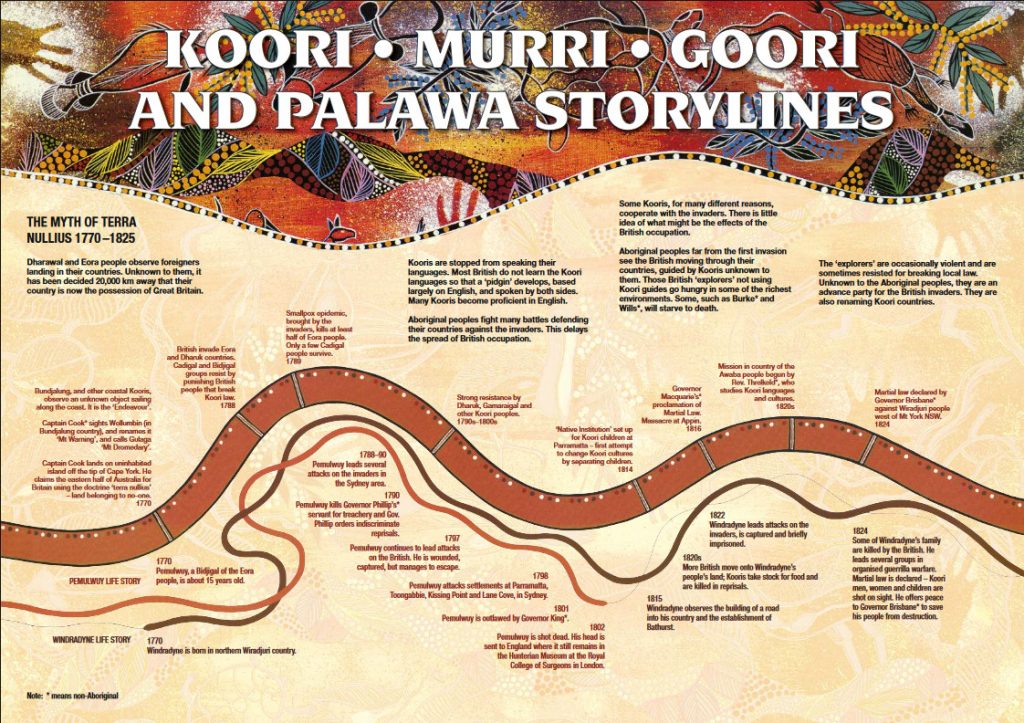Lesson overview
Outcomes
- Students examine the notion of terra nullius under which Australia was settled. Students consider the implications of a treaty between the Australian Government and the Indigenous Peoples.
- Students compare the economic and social outcomes for Australia’s Indigenous people under terra nullius with those of other Indigenous peoples with earlier agreements.
Introduction
Captain Cook’s instructions from the British Government (National Archives/NSW documents) at the start of his journey in 1768 included:
You are also with the Consent of the Natives to take Possession of Convenient Situations in the Country in the Name of the King of Great Britain: Or: if you find the Country uninhabited take Possession for his Majesty by setting up Proper Marks and Inscriptions, as first discoverers and possessors.
On Possession Island, on Wednesday 22 August 1770, Captain Cook, ignoring obvious signs of habitation, declared the coast a British possession and later wrote:
Notwithstand[ing] I had in the Name of His Majesty taken possession of several places upon this coast, I now once more hoisted English Coulers and in the Name of His Majesty King George the Third took possession of the whole Eastern Coast . . . by the name New South Wales, together with all the Bays, Harbours Rivers and Islands situate upon the said coast, after which we fired three Volleys of small Arms which were answered by the like number from the ship.
No consent was sought or granted.
Resources needed
- IWB/Butchers paper/A3 paper
- Pens
Activities
Read the proclamation of Terra nullius and What is a treaty? [RTF]
1. Class discussion: What is Terra Nullius? What is a treaty?
Students read (on digital device, IWB screen or individual copies ) the two documents and discuss.
2. Jigsaw activity
- Download Issues worksheet.
- Divide the class into 5 groups.
- Distribute an issue and A3 or butchers paper and pen to each group.
- Why are we talking about a treaty?
- What might the benefits of a treaty be for both Indigenous and non-Indigenous Australians?
- What legal status and form could a treaty take?
- What processes are needed to arrive at a treaty and who should be involved?
- What are some of the reservations about a treaty?
- Group discusses their issue and further researches if necessary.
- Each group records their thoughts on A3 paper or butchers paper.
- Each group presents their ideas to the class and invites further comment.
3. Independent task
Students individually summarise the issues and write reports What about a treaty?
Additional strategies
Australia is the only Commonwealth country never to have entered into a treaty agreement with its Indigenous people. Consider the outcomes of the agreements made or not by the British Governments of the day with the Indigenous peoples of near neighbours Australia (Terra nullius), New Zealand (Treaty of Waitangi 1840) and Fiji (Deed of Cession 1874).
- Divide the class into three and research the following issues for each country:
- What were the events leading up to the settlement of Australia, the Treaty of Waitangi and the Deed of Cession?
- What were the principles of each agreement?
- What are the present day social and economic outcomes for the Indigenous peoples in terms of autonomy, land rights and human rights? Groups present findings to class.
- As a class compare the outcomes for Indigenous peoples of terra nullius, the Treaty of Waitangi and the Deed of Cession.
Related resources
Posters originally published in 1995 by the Aboriginal Curriculum Unit of the Board of Studies as part of the education kit ‘Invasion and Resistance: Untold stories – Aboriginal voice in Australian history’
Copyright
Additional Instructions for Lt James Cook, appointed to command His Majesty’s Bark the Endeavour, issued on 30th July 1768. National Library of Australia, MS 2
Documenting a democracy, National Archives.

